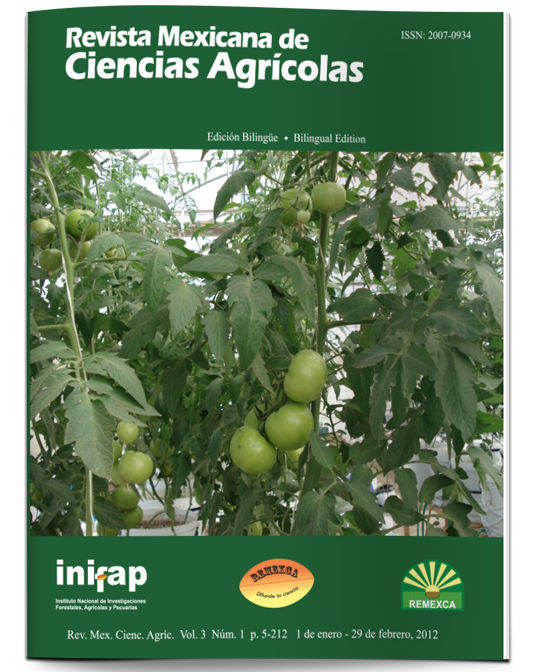Response of different varieties of cereals to inoculation with Bradyrhizobium sp.
DOI:
https://doi.org/10.29312/remexca.v3i1.1493Keywords:
Triticum, Zea mays, bio-fertilization, varietiesAbstract
Two field experiments were performed in 2009 at the Experimental Station of Pastures and Forages Sancti Spiritus, Cuba (21° 53’ 00” north, 79° 21’ 25” west longitude and 40 m) to determine the response of different varieties of cereals to bio-fertilization with Bradyrhizobium sp. The preparations of inocula and seed inoculation were made according to preset methodologies for this field of study. The experimental design was through split-plots and 4 replicates per treatment. The fertilized control was applied with nitrogen (150 kg N ha-1) and agronomic variables were evaluated. We applied two- factor analysis of variance; the differences between means were determined by Duncan and t-student comparison. In the experiment with Triticum, we concluded that, the treatment with the best responses was Triticale- inoculated and IRM37-inoculated and that, Triticum secale exceeded on root dry weight and stem length compared with T. aestivum, which makes this first promising species for drought conditions. In the experiment with Zea mays is concluded that, even though air dry weight treatments were best with chemical fertilization, in dry weight of the ear Canilla-inoculated treatment showed statistically equal to that of the fertilized treatments, so it ́s considered a positive response of this variety to bio-fertilization. However, the inf luence of indigenous rhizosphere bacteria in some of the studied variables is not ruled out.
Downloads
Downloads
Published
How to Cite
Issue
Section
License
The authors who publish in Revista Mexicana de Ciencias Agrícolas accept the following conditions:
In accordance with copyright laws, Revista Mexicana de Ciencias Agrícolas recognizes and respects the authors’ moral right and ownership of property rights which will be transferred to the journal for dissemination in open access. Invariably, all the authors have to sign a letter of transfer of property rights and of originality of the article to Instituto Nacional de Investigaciones Forestales, Agrícolas y Pecuarias (INIFAP) [National Institute of Forestry, Agricultural and Livestock Research]. The author(s) must pay a fee for the reception of articles before proceeding to editorial review.
All the texts published by Revista Mexicana de Ciencias Agrícolas —with no exception— are distributed under a Creative Commons License Attribution-NonCommercial 4.0 International (CC BY-NC 4.0), which allows third parties to use the publication as long as the work’s authorship and its first publication in this journal are mentioned.
The author(s) can enter into independent and additional contractual agreements for the nonexclusive distribution of the version of the article published in Revista Mexicana de Ciencias Agrícolas (for example include it into an institutional repository or publish it in a book) as long as it is clearly and explicitly indicated that the work was published for the first time in Revista Mexicana de Ciencias Agrícolas.
For all the above, the authors shall send the Letter-transfer of Property Rights for the first publication duly filled in and signed by the author(s). This form must be sent as a PDF file to: revista_atm@yahoo.com.mx; cienciasagricola@inifap.gob.mx; remexca2017@gmail.
This work is licensed under a Creative Commons Attribution-Noncommercial 4.0 International license.



